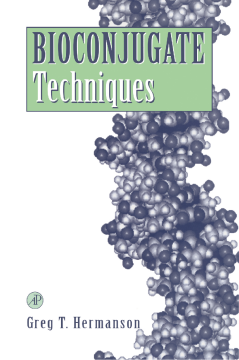
Additional Information
Book Details
Abstract
Bioconjugate Techniques is the essential guide to the modification and crosslinking of biomolecules for use in research, diagnostics, and therapeutics. It provides highly detailed information on the chemistry, reagent systems, and practical applications for creating labeled or conjugate molecules. It also describes dozens of reactions with details on hundreds of commercially available reagents and the use of these reagents for modifying or crosslinking peptides and proteins, sugars and polysaccharides, nucleic acids and oligonucleotides, lipids, and synthetic polymers. Armed with this information and the abundant protocols provided, readers will form unique complexes that can be used for detecting, quantifying, and targeting important analytes.
This book helps readers make: high activity antibody-enzymes conjugates, immunotoxins, immunogen complexes, liposome conjugates; as well as biotinylated molecules, avidin or streptavidin conjugates, colloidal gold labeled proteins, PEG or dextran complexes, labeled oligonucleotide probes, and fluorescently tagged or radiolabeled molecules.
- This book is the first to thoroughly capture the entire field of bioconjugate chemistry in a single volume
- Serves as a practical guide to modification and cross-linking technology for research, diagnostics, and therapeutics
- Provides useful, detailed, easy-to-follow, step-by-step protocols
- Contains easy-to-read, and easy-to-understand key concepts for making bioconjugates of all types
- Efficiently covers the chemistry of bioconjugation, the major reagents available for modification and cross-linking, and the application of these reagents to the synthesis of highly active conjugates
- Cites over more than references keyed to concepts covered in the book
- Uses more than 600 figures to illustrate bioconjugate reagents, their reactions, and applications
- Suggests sources for all key reagents
"This is a well-organized and well-written book; it is readable and comprehensible to the novice, but its content and stylistic approach seem sufficiently sophisticated to appeal to active, knowledgeable workers in the field. It is an impressive compilation of useful theoretical and practical information that is not readily available elsewhere in a single volume." --Joseph G. Cannon in JOURNAL OF MEDICINAL CHEMISTRY
"The presentation throughout is that of a laboratory manual. Well-illustrated descriptions of a particular chemical reaction are followed by a detailed protocol and list of references extending into 1994. The coverage of reagents and methods is comprehensive, and sources are given for commercially available compounds." --NATURE
